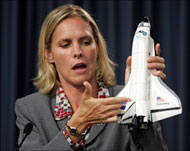Nasa seeking cause of malfunction
Nasa engineers are searching for the cause of a fuel-sensor problem that kept space shuttle Discovery from flying, delaying the first shuttle mission since the 2003 Columbia disaster.

The US space agency called off Wednesday’s much-anticipated launch of Discovery less than three hours before the scheduled mid-afternoon lift-off.
The next attempt could be on Saturday at the earliest, but first Nasa must figure out why the fuel sensor malfunctioned, and that could take time.
Engineers’ trouble-shooting meetings at Kennedy Space Centre in Florida began early on Thursday, with a closed-door gathering of mission managers set for midday.
Even after that, a launch timetable may not be clear.
Nasa has until 31 July to launch Discovery, a deadline dictated by its planned rendezvous with the International Space Station and a new requirement that all shuttle launches take place during daylight hours.
If Discovery fails to launch this month, the next window of opportunity begins 9 September.
Any substantial delay after that could threaten construction of the orbiting station and perhaps the long-term plan to return humans to the Moon and eventually to Mars and beyond.
Intermittent problem
Nasa experts acknowledged that the sensor problem – which they described as an intermittent event with no obvious cause – represented a difficult challenge.
“It does at this stage remain an unexplained anomaly. It reminds me of an old truck I owned with an intermittent electrical problem. Unexplained anomalies are the worst ones” Wayne Hale, |
“It does at this stage remain an unexplained anomaly. It reminds me of an old truck I owned with an intermittent electrical problem,” said deputy shuttle programme manager Wayne Hale. “Unexplained anomalies are the worst ones.”
The faulty sensor is one of four that would cut off the shuttle’s three main engines if at least two showed that hydrogen fuel was running low.
A premature cut-off might damage the engines, force the shuttle to make an emergency landing or leave it short of its desired altitude.
Discovery’s planned lift-off from Cape Canaveral marks the first shuttle mission since its sister ship Columbia fell apart over Texas on 1 February 2003, killing all seven astronauts.
Falling foam from Columbia‘s external fuel tank had knocked a hole in its wing at lift-off 16 days before.
The shuttle disintegrated when superheated gases tore into the breach on re-entry into the Earth’s atmosphere.
Delays caused by bad weather and technical problems have bedevilled shuttle launches in the past.
Wider attention
But this mission has gained wider attention because the fleet of three remaining shuttles has been grounded since the Columbia disaster.
Nasa managers said their readiness to call off Wednesday’s scheduled launch even after Discovery’s seven-member crew had been strapped into the spacecraft reflected a new aversion to risk in the wake of the Columbia disaster.
 |
|
Nasa says the fault sensor could |
In addition to testing new safety measures and experimental heat-shield repair techniques, Discovery will take much-needed supplies and equipment to the space station.
The 16-nation space-station project has been on hold since Columbia crashed because the US shuttles are the only spacecraft capable of lifting heavy components to orbit.
Nasa aims to keep the shuttles flying until 2010 so the station can be completed. The aging shuttles will then be retired and replaced by a new generation of spacecraft.
While engineers worked to fix the hydrogen fuel sensor, Discovery’s crew, led by veteran commander Eileen Collins, remained in Cape Canaveral to continue training flights.
Should the delay extend beyond Saturday, the astronauts would probably return to Houston, Nasa said.